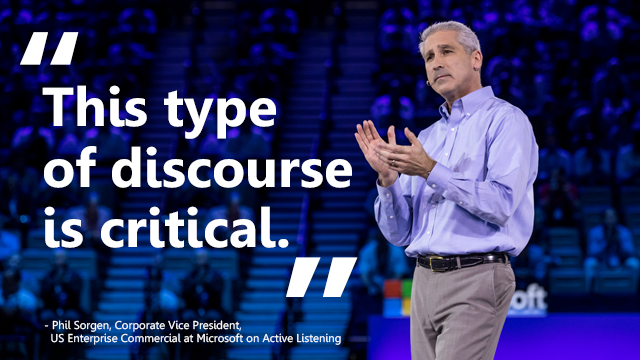
Attentive to detail: practicing inclusive communication
Microsoft CEO Satya Nadella has frequently said that we need to change from a “know-it-all” company to a “learn-it-all” company. This statement rings true to me in a multitude of ways. In our busy lives it’s often difficult to find moments to commit ourselves to formal instruction, so I advocate for approaching every conversation as an opportunity to learn.
That only works when you practice inclusive communication and active listening: Not just waiting for a chance to respond, but instead internalizing what others say and thoughtfully engaging in a meaningful dialogue inclusive of all perspectives. This type of discourse is critical to developing talent, so much so that 64% of the 25,000 people polled in the Global Leadership Forecast 2018 ranked it in their top five challenges.1 Business leaders and CEOs are clearly making inclusive engagement a priority, and we should all strive to do the same.
How to practice inclusive behavior: Never assume there’s nothing to learn
I’ve led large global and nationwide teams for many years now, spanning our partner ecosystem and sales from small and mid-market up to our largest global enterprises. With this experience, it would be easy to assume I’ve seen it all. In fact, nothing could be further from the truth.
Our world is changing every single day, and the second you get complacent about learning and improving, you run the risk of being left behind. I’m often short on time to read books or complete formal learning modules, but I can always talk to others around me. When traveling to meet with customers, partners, and my own team, I prioritize question-and-answer sessions whenever possible, asking others about their challenges and listening to their ideas.
To get the most out of these connections, I make sure to practice certain behaviors to be an active listener and inclusive communicator.
- When people are engaging with a lot of information all at once, taking a moment to pause and ask, “Did you get all of that?” is helpful. I appreciate this courtesy when I’m on the receiving end as well.
- In the same vein as pausing, rephrasing what people have just told you lets them know you’re listening, and gives you a chance to reiterate the main points to ensure you’ve gotten everything correct.
- Picking up on cues. Watch your listener for nonverbal cues. Are they meeting your eyes? Leaning in? Nodding in agreement?
- Researching your subject. Prepare for meetings, big and small. Research everyone on LinkedIn, review notes from previous team meetings, and talk one-on-one with colleagues if you notice any communication blocks.
- Inviting feedback. Different listeners have different feedback styles. I mention pausing in this list, but sometimes people have trouble speaking up in a meeting setting. Inviting feedback after the meeting is over, via e-mail or tools like Microsoft Teams offers an alternative while being inclusive.
We must commit to learning in order to keep growing, and feedback through active listening and inclusive communication is critical. Leveraging the behaviors above and adapting them to your personal style is a great place to start developing your “learn-it-all” mindset.




